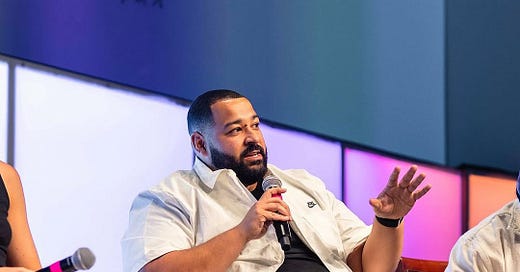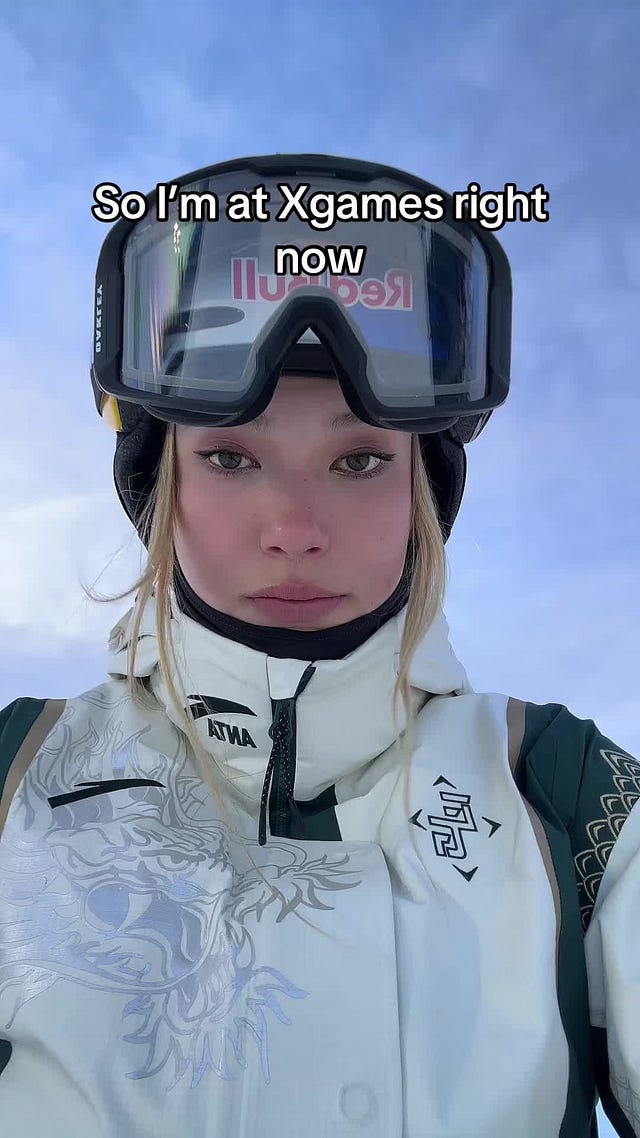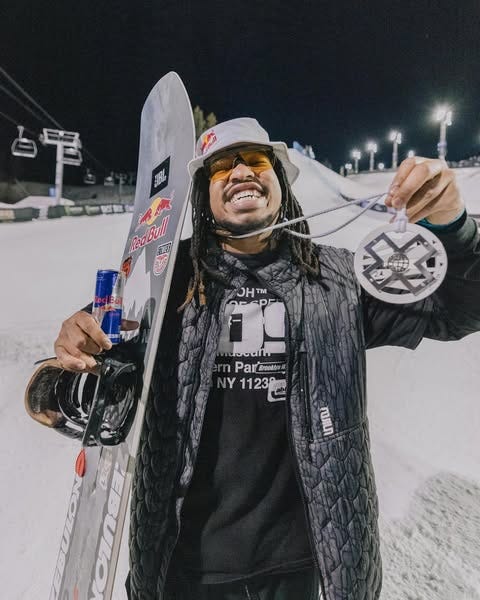Welcome to “Creator Conversations,” a weekly feature on Paid Partnership where I interview a prominent creator, agent, marketer or industry professional to discuss wide-ranging topics from outreach to negotiation to content.
As a lifelong snowboarder myself, it’s been amazing to watch and study the evolution of winter action sports over the past 15-20 years. From ever-rising lift ticket prices to shorter Winters across the globe, these sports are arguably less accessible than ever yet there’s an amazing community of young, diverse stars leading the next generation - Putting skiing and snowboarding not just back on the mainstream map but growing the activities by reaching new fans around the world.
With my passion for snowboarding only increasing with age, I’ve relished the opportunity to get to know and learn from the man behind X Games social media: Devin Dismang.
Devin brings his incredibly impressive traditional sports resume (Golden State Warriors, STN Digital, etc.) to work daily, developing a professional and creative approach to the feeds - All with an action sports twist.
On the heels of Winter X Games in Aspen, I tracked down Devin to discuss:
Tips for experiential activations (even on a low budget)
The future of athletes as creators
How thinking like a creator can turn your home videos into lifelong memories
And more!
Neil: From Jimmy Butler to AJ Greene, you’ve been able to host some of the top professional athletes and sports creators at X Games. Can you share your process? (How you secured them, itinerary, content capture, etc.)
Devin: A lot is a combination of luck and experience. Being from the mainstream sports world, I have connections and relationships I've used to bring athletes to X Games, a nontraditional sport and execution. The main selling point is the overall experience. These guys have been to NHL games, NBA games, soccer games - events they've seen before. I can almost guarantee none have been to X Games. But all have some interest in action sports, whether as casual snowboarders or Tony Hawk’s Pro Skater fans growing up.
The Jimmy Butler tie-in was one of the bigger ones last year. He was close with Leticia Bufoni and jokes that he's Brazilian. When I invited him, he was excited because he had wanted to see her perform for years. We gave him the VIP experience, and he embraced it. Jimmy, as a character, goes all out. My job is to show them such a great time that they want to do everything. He made a custom sign, hopped on our Twitch broadcast—none of it was scheduled. He just saw it and wanted to be part of it.
With AJ Greene, he recently got into snowboarding. You probably saw videos of him learning. He wanted to see X Games, watch the pros, and meet people in the sport. We connected him with LJ Henriquez, a 16-year-old snowboarder - half Black, half Dominican, from Brooklyn. It was a way to engage not only athletes of color but also those already working with kids from diverse backgrounds. Instead of pairing him with a veteran who wouldn’t relate, we made it meaningful. For these athletes, it's a big deal. They rarely get exposure in mainstream culture.
Neil: Finding people with ties to your sport but exist outside of your community is key. You tracked down that AJ Greene had snowboarded once, saw the opportunity, and capitalized on it.
Devin: People play basketball, baseball, and soccer casually, but it's rare to find someone who was an avid skateboarder at 14 and is now an NBA player. Or someone who tried snowboarding on a group trip years ago and got into it. Selling the event is easy because the average person doesn’t grasp the skill level involved. You understand it if you snowboard, but most don't.
It's harder to convince someone with no experience to come. But if they've skied once, they know how difficult it is. Watching a 15-year-old launch four stories into the air and land six spins is unbelievable. One of my pitches to creators, athletes, VIPs—even my mom—is that this is something you must see in person. It looks too easy on TV.
Neil: Curious how you approach experiential activations especially given a smaller budget combined with the high cost of Aspen (for Winter X Games).
Devin: We have tight budgets across the board than most traditional sports. Action sports don't generate NBA, NFL, or NASCAR revenue just yet, so we sell the experience. If you're going to Aspen and want to snowboard for the first time, I'll set you up with guides, boards, and brands to enhance the experience. I'll also introduce you to an athlete who matches your energy.
It's different from other sports. I'm a die-hard Steph Curry fan, but even as a big creator, most of the time - you’re not meeting Steph. Only a handful of people get that access. But I can connect you with Eileen Gu, Zoi Sadowski-Synnott, or Chloe Kim, and you’ll be able to get access or create with them on the mountain (schedules pending of course).
Neil: We all know how securing player access can be challenging in team sports - So are your athletes more receptive to pitches that involve collaborating with a creator?
Devin: Absolutely. They don’t get these opportunities often. Action sports athletes are on the sidelines of mainstream events. Take the Super Bowl—you didn’t see an action sports athlete there, aside from Nigel Sylvester with Jordan Brand. But at X Games, you can meet someone who just landed their first triple backflip.
Action sports athletes are creators at heart. They film mixtapes, produce video parts, and travel the world to make content. They were the original YouTubers before realizing it. Now, content creation is part of their income.
Eileen Gu is a great example. She’s an Olympic gold medalist and X Games champion, but 99.9% of her earnings come from sponsorships. She edits and shoots her own TikToks. Chloe Kim started vlogging events on Instagram because fans wanted to see her life beyond competition. Zoi Sadowski-Synnott, Colby Stevenson, and others have launched YouTube channels.
Arisa Trew, a 15-year-old skateboarder and one of the best in the world, started a YouTube channel because she loves creating. In the past, action sports content was all about adrenaline—crazy stunts, maybe getting hurt, real Jackass-style. Now, it’s both—high-level action with personality. Athletes used to be hidden behind helmets and goggles. Now, they’re front and center, engaging with fans in new ways.
 Tiktok failed to load.
Tiktok failed to load.Enable 3rd party cookies or use another browser
Neil: Right. You're either competing a couple times a year on the biggest stage or filming for a video part for one to three years. On that note - Shout out to our boy Jared McCain doing his TikTok dances.
Devin: Jared McCain one time—shout out to Philly. If I could work with one athlete right now, Jared McCain would be on top of that list because he is so good.
Neil: That reminds me of your panel at the Gondola Sports Summit: The power of YouTube and becoming a creator, even as a professional athlete.
Devin: For some reason, it continues to be underutilized by professional athletes and creators alike because it is intimidating. We say, "Start a TikTok page, start an Instagram page, start a YouTube channel." Many athletes hesitate because it feels like a lot of legwork. If you're looking for full-fledged production, great. But I’m watching kids play with toys on YouTube right now [Devin’s daughter enters the call holding a phone close to her face], and it has 10.2 million views because it's tailored to a specific audience. You could shoot iPhone footage in 4K with an SSD on the back, do simple follow-cam footage, and still get a million views.
We tend to overthink this because we're used to high production. Now, you can have a full televised production in the palm of your hand, yet we undervalue it when it comes to YouTube. People assume they need big cameras, but some of the best content is shot on a GoPro going down a mountain or on vert ramps. YouTube right now is the best place for organic monetization. As a brand, we take it seriously and preach it to our athletes.
We're working on an athlete summit—a playbook to help build social and content presence. We provide a full breakdown on how to do YouTube. Our team will help you grow, build, and provide resources, but at the end of the day, you have to want to do it. I can't put the camera in your hand and press record.
Neil: You mentioned LJ, Zeb Powell, and increasing representation. I remember growing up with LJ when he was a kid, wild to see what he’s already accomplished in his young career. Curious about your reflections on impacting diversity in action sports, whether through brand marketing or your role in social.
Devin: When I joined X Games over a year ago, I was the only person of color here—the only Black representation in the company. When I look for creators or athletes, I seek people of color and culturally non-endemic individuals.
I can bring endemic creators and athletes to X Games—we're already talking to them. But we’re engaging fashion brands, family creators, or mainstream sports creators who watch X Games from afar but don’t know how to get involved. We’re also talking to kid creators. Last year’s youngest gold medalist was 9. Another medalist in women’s vert was around the same age. Athletes range from 10 to their 30s.
As a 30-year-old, I care about what a 32-year-old is doing, not what a 14-year-old is doing on TikTok. But my niece, who’s 10, will think that 14-year-old is awesome. We have to reach all demographics, not just endemic ones. We also need casual fans—new audiences to grow the sport.
My daughter, who’s three, saw someone trying to skateboard (badly) and now has her own longboard. I tried skating since I was 12, but now, at 35, my knees are shot. Diversity in showcasing is important. Over the last few years, more people of color have tried snowboarding and skiing than ever before.
There’s a cultural barrier in skiing and snowboarding due to the cost—boards, rentals, lift tickets. But smaller, more affordable mountains exist. Maybe it's not Aspen, but you can still have a great experience. Seeing someone at X Games who looks like you makes a difference.
During Black History Month, we talked about LJ breaking barriers, but Zeb is the barrier breaker. Over the last three weeks since Aspen, I’ve seen more Zeb Powell highlights and edits than ever. People are discovering him. KevOnStage posted about him, and it went viral. We took immediate advantage—reached out, made plans. We also just did a Make-A-Wish event in Aspen for a kid whose wish was to spend the day with Zeb.
Action sports athletes set trends in fashion and culture. Historically, it was predominantly white, but now more people of color are involved across all sports, and it's only growing. These trends are breaking barriers, and athletes know they’re being watched. They embrace that responsibility.
Neil: Shout out to my Hoods to Woods family — Brian and Omar are incredible. One thing I admire about you as a creator is that you practice what you preach. Japan travel vlogs, streaming content—how do you fit it all in? And do you apply what you learn to the creators you hire? (Watch Devin’s YouTube)
Devin: Funny enough, I’m behind on two vlogs. But I live by this code: I won’t ask someone to do something I wouldn’t do myself. It helps me understand creators better.
For example, when Duke Dennis came to Aspen, he wanted to vlog but wasn’t sure what to do. I thought, “If I were vlogging, I’d showcase the mountain, meet an athlete, engage with fans, and try an activity.” He wanted to try snowmobiling, so we made that happen. Instead of an aimless conversation, we created a structured plan. That approach makes the process smoother for everyone.
I wish I could create more, but I have creator anxiety—I feel behind. I still have unedited X Games Japan footage from last year. Work is work.
A big part of this is for my daughter. She’s three, and kids love YouTube. She watches videos on our phone all the time. People say, “Don’t take kids to Disneyland—they won’t remember.” Maybe not, but she’ll have videos.
We create home videos, even if they’re not public. They don’t need to be cinematic masterpieces. If the audience is just her, that’s enough. She’ll only know me as a 45-year-old in 10 years, but with these videos, she’ll see our lives as they were.
Life moves fast. Things happen. I don’t want her to have just a few vague memories. That’s why I feel guilty when I fall behind—I need to back everything up. We save everything on hard drives in a memory box, so when she’s 18, she’ll have access to her life story.
I love capturing moments, editing, and publishing, even privately. Many people have old VHS tapes and unorganized photos, but if you take the time to create a monthly recap vlog, it’s a well-preserved memory.
People assume platforms like YouTube will last forever, but one social platform outage for half a day had the world in a panic. If YouTube disappears, so do thousands of videos. That’s why I back everything up.
Our hard drives are meticulously organized—my daughter’s life, month by month, special events, Japan vlogs, photos. If you mapped it out, you could see her entire life in one place. Worst case, we upload everything to a private YouTube playlist.
We all have phones and cameras—everyone is a creator now. A three-year-old on the couch, your mom taking iPad photos—everyone. You could be nobody today and famous tomorrow with one viral moment.
Neil: Amazing.








